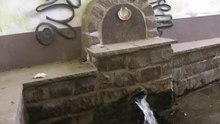St. James (fish)
The Church of St. James is James the Elder devoted Roman Catholic parish in the district of the Rhineland-Palatinate fish , district Trier-Saarburg . The church is located below and outside of today's location on the route section from Trier to Metz on the Way of St. James , which was re-marked in the 1990s . The church is in an idyllic, secluded valley location in the Mannebach valley . The church building is a cultural monument .
history
The settlements of Littdorf and Rehlingen go back to the conquest of Franconian clans in the 8th century. In the course of the Christianization of the Franks around the year 800, a wooden church is likely to have been built in the area of today's church, which was replaced in the 11th century by a church roughly the size of today's church made from the sandstone of the area. The builders were the imperial knights von Bellenhausen.
Today's church was originally the parish church of the abandoned Littdorf settlement, of which only the church has been preserved, and the Rehlingen estate, which was above the church in the direction of Körrig. The first mention of the church comes from the taxa generalis of the archbishopric around 1330. The church is today (2016) parish church of the parish Litdorf-Rehlingen includes the places Fisch, Rehlingerhof and Kahren .
The church was also the parish church of Mannebach , Körrig and Kümmern until 1803 and of Kahren until 1812. It was renovated regularly, most recently in 2000. Today (2016) it belongs to the Saarburg parish community and is only occasionally used for church services.
Church building
The church replaced the previous Romanesque building, of which the tower is still preserved.
The Romanesque tower made of sandstone rubble is the oldest part of the church. It has acoustic arcades on the north, east and west sides. The church consists of a two-axle nave from 1793, which is built directly onto the tower, and a three-sided closed choir from 1667. The tower has a portal from the year the ship was built. The cross-vaulted tower hall allows passage to the ship, which is normally closed off by a modern protective grille.
Furnishing
The church has baroque furnishings from the time the ship was built: three wooden altars, a pulpit. The main altar is dedicated to James the Elder and contains relics of Simon von Trier, the side altars were originally dedicated to the Mother of God Maria and Lucia. The latter was later replaced by a Sacred Heart statue and is now to the right of the high altar. In the high altar itself, the figure of James and the oil painting of the sacrifice of Melchisedech were added later in the upper part. The Rococo pulpit, which today has no stairs, bears the year 1756. On the left wall of the choir there is a relief of Oswald von Bellenhausen who was murdered by robber barons in an attack .
Bells
There are two historic bronze bells in the bell tower: The smaller bell is known as a pointed hat or sugar loaf because of its shape . It was probably a gift from the von Bellenhausen family and was cast around 1250. The big bell from 1594 was a gift from the nobles von Warsberg, who had owned the Rehlinger Hof since 1557. It is a so-called weather bell and decorated with Gothic ribs. Their inscription reads: "IN GOD'S NAME, ICK - CHANGE THE WEATHER OUT ICK - JAKOB THE GREAT HISH ICK - ANNO DOMINI 1594 - PBR".
meaning
The special importance of the church lies in the fact that a type of church (relatively small church with a Romanesque tower with a baroque nave) has been preserved here, which was still widespread in the Saar-Upper Moselle region until the middle of the 19th century. Due to the growing population, these churches have become too small for most places and have been replaced by much larger neo-Gothic new buildings.
opening
The church is normally open during the day until the protective grille.
The Bruoder Boar
In the immediate vicinity of the churchyard is the so-called Bruoder Boar. This is a spring with a well house .
A spring with never-ending water may have been the basis of the Frankish settlement of Liethdorf, founded after 454 . Today's source is 1.5 m below the surface and was part of the Western Wall construction in the construction of today almost disappeared railway line wasserliesch-Freudenburg, only a single viaduct exists something above the church of the, of the Organization Todt discovered (OT) and cistern-shaped . In 1966 the fountain system was fortified with a simple concrete wall extension. In 2005/06 the municipality of Fisch redesigned the Bruoder Boar with the support of LEADER PLUS Geldern with the construction of the Jakobus Pavilion. It was after the last pious recluse, 1783 in the church tower swallow's nest-like attached and before 1914 broken Klause lived.
literature
- Georg Dehio : Handbook of the German art monuments, Rhineland-Palatinate and Saarland. Deutscher Kunstverlag, Munich 1984.
- Ernst Wackenroder: The art monuments of the Rhine province; Saarburg district; 1939.
Web links
- Parish community Saarburg
- Internet presence of the local parish Fisch: Article about the church by Michael Winter from 2002.
References and comments
- ^ General Directorate for Cultural Heritage Rhineland-Palatinate (ed.): Informational directory of cultural monuments - District of Trier-Saarburg. Mainz 2020, p. 9 (PDF; 6.5 MB).
- ↑ Internet site of the parish community Saarburg, accessed on May 6, 2016.
- ↑ Information board at the fountain house, as of April 2016.
Coordinates: 49 ° 36 '59.2 " N , 6 ° 30' 7.4" E




